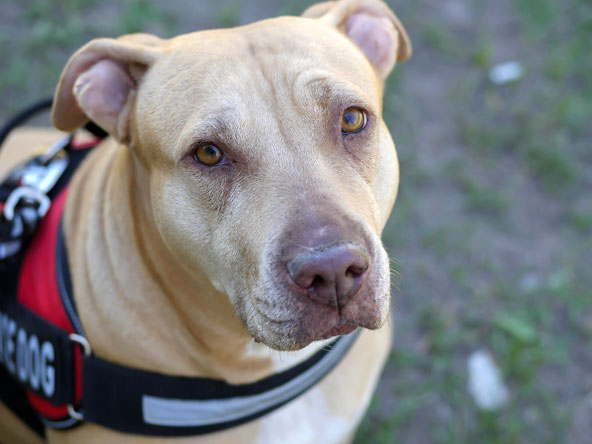Honoring Service Dogs

September is National Service Dog Month, which is all about honoring the hardworking dogs that serve individuals with disabilities of all kinds. It is also meant to celebrate the people who contribute to their success. In honor of this special celebration, below are some interesting facts about service dogs.
- Service Dogs Can Be Any Color, Size, or Breed
There’s nothing that says Service Dogs can only be Labrador retrievers, golden retrievers, or German shepherds. While those three breeds are some of the most commonly seen service dogs, absolutely any dog with the proper temperament, good health, and structure, and the physical capability to do the job their person needs them to do can be a service dog, regardless of color, size, or breed.
- Service Dogs Come in Multiple Varieties
Everyone knows what guide dogs are, and most people have heard of hearing dogs. People often know immediately that a dog wearing a special harness and partnered with an individual in a wheelchair is a service dog, although they may not know exactly what that dog does for its person. However, there are well over a dozen distinct varieties of service dogs, including, but not limited to:
- Allergy Alert Dogs
- Autism Assistance Dogs
- Brace and Mobility Support Dogs
- Emergency Medical Response Dogs
- Diabetic Alert Dogs
- Hearing Dogs
- Guide Dogs
- Medical Alert Dogs
- Medical Assistance Dogs
- Medical Response Dogs
- Psychiatric Service Dogs
- Seizure Alert Dogs
- Seizure Assistance Dogs
- Seizure Response Dogs
- Visual Assistance Dogs
- Wheelchair Assistance Dogs
- Service Dogs Aren’t Just for Emotional Support
Service dogs don’t just offer companionship and emotional support to their people. In fact, any dog that does that and only that isn’t a service dog — it’s an emotional support dog. In order to be a service dog, a dog has to possess specialized training that mitigates some part of its handler’s disability. It can’t be a behavior the dog offers naturally, either, since that isn’t a trained behavior. It must be a specific, predictable behavior tied to a cue or trigger that the dog performs reliably in order to be considered trained task work.
- Service Dogs Perform Specialized Work and Tasks for Their Person
Service dogs possess specialized training that mitigates their person’s disability. Depending on the type of service dog, the dog may have anywhere from three to a dozen different tasks or even more! Some examples of service dog tasks include:
- Retrieving dropped items
- Opening and closing doors
- Turning lights on and off
- Pulling a wheelchair up a slope
- Licking a seizing person to help end the seizure via tactile stimulation
- Alerting a diabetic person to dangerous shifts in blood sugar
- Bracing an unsteady or unbalanced handler
- Service Dogs Aren’t Required to Wear Gear
In the United States, there is no required gear for service dogs. A service dog is a service dog regardless of what it is or is not wearing, and its handlers possess the exact same access rights with or without their dog in gear. Vests, harnesses, and jackets are very commonly seen on working service dog teams, but by law, the dog isn’t required to wear anything in order to work in public.
To support service dog programs, and help continue this extremely valuable work, please consider donating your time or money to a local service animal training and advocacy organization.
Amber Slaughter, DVM
Medical District Veterinary Clinic
